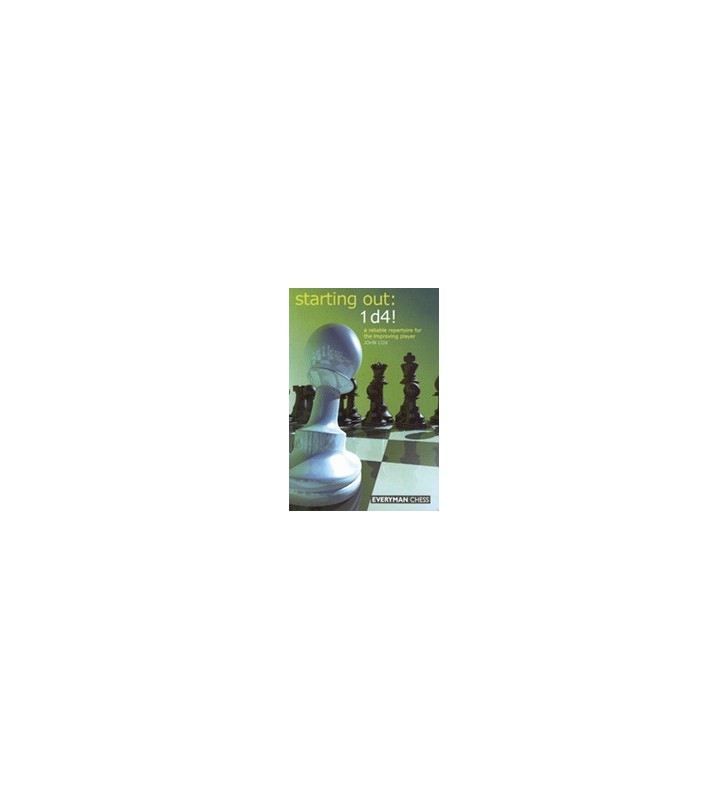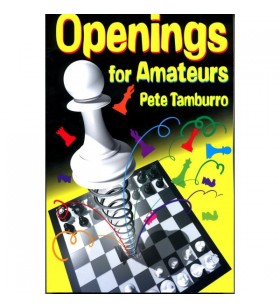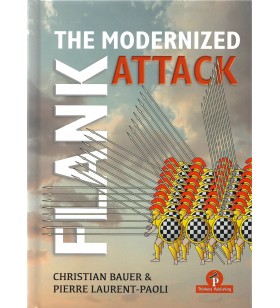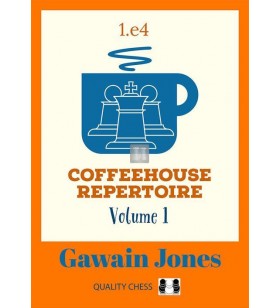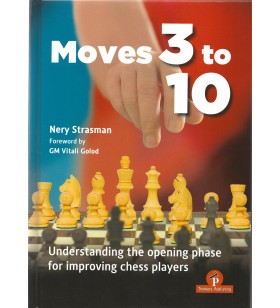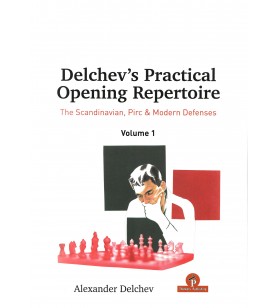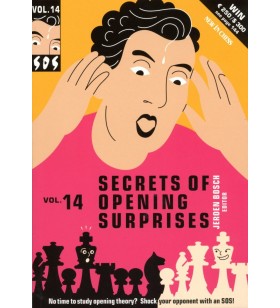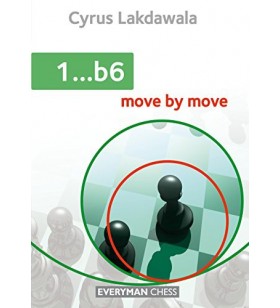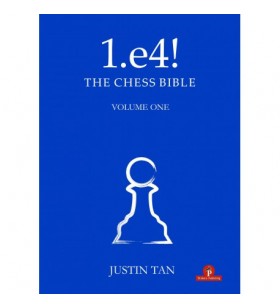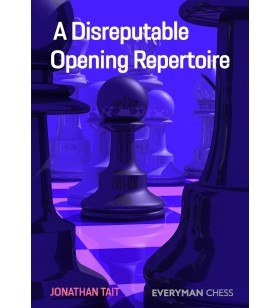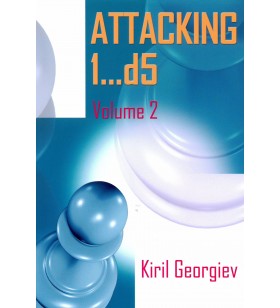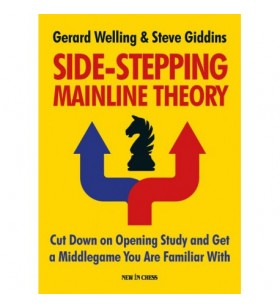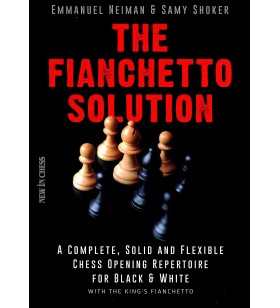- CHESS
- Chess boards and pieces
- Chess books
- Chess books in English and others
- Opening books
- The Ruy Lopez
- Other open games
- Other semi-open games
- The Sicilian
- French Defence
- Pirc & Modern Defence
- Caro-Kann
- Queen´s Gambit
- Slav Defence & Semi-Slav
- Other closed games
- Other semi-closed games
- King´s Indian Defence
- Nimzo & Queen´s Indian
- Grünfeld
- English Opening
- Dutch Defence
- Miscellaneous openings
- General and repertoire books
- Endgame books
- Books on grandmasters
- Books on tournaments
- Books in Dutch
- Miscellaneous
- Chess magazines
- General and middle game books
- Opening books
- Chess books in French language
- Chess books in English and others
- Chess software and DVDs
- Chess computers
- Equipment for clubs
- BOARD & BRAIN GAMES
- GO
- BRIDGE & CARDS & TAROT
- POKER & CASINO GAMES
- PUZZLES & BRAIN TEASERS
- DARTS
COX - Starting out : 1d4!
 Livraison sous 48 heures via Bpost*
Livraison sous 48 heures via Bpost*
Livraison gratuite à partir de €69 (Belgique, France, Pays-Bas, Luxembourg, Allemagne)
 You can cancel your order
You can cancel your order
For fourteen days!
 Secure payments
Secure payments
All payment cards accepted.
16 other product
Bauer/Paoli - The modernized flank attack
The g2-g4 (or ...g7-g5) pawn push is considered unconventional and often associated with backroom chess games or old-fashioned openings like the King’s Gambit.
Despite being one of the most weakening moves available, g2-g4 has been seen more frequently at the top level of chess.
While g2-g4 (or ...g7-g5) can lead to interesting fights, it also entails considerable risk and often results in messy, non-traditional positions with higher chances of mistakes.
It's crucial to remain objective and not get carried away by the excitement of launching an attack, as aggressive pawn pushes can quickly backfire.
The book aims to cover a wide range of chess openings involving g4 (...g5), regardless of whether the idea is strong, interesting, or unadvisable.
Over 50 games are analyzed, showcasing different scenarios where the g-pawn push is utilized, including attacking a short-castled king, challenging the stability of a knight on f3 (or ...Nf6), and seizing space on the kingside.
The examples illustrate a mix of these three reasons, with one prevailing in each case.
The authors, Pierre Laurent-Paoli & Christian Bauer, hope readers will enjoy exploring the lines presented in the book and implement them into their own play. 359 pages Hardcover
Strasman - Move 3 to 10
I used to play a lot of chess as a teenager many decades ago. Those days, there were hardly any computers that played the game and there was certainly no Internet. Learning new ideas in the game was possible only through books or magazines and if something was not clear, there weren’t too many people to consult for explanations. I was never a great player and quit when other things in life took precedence. Then, a few years ago, I decided to start playing again and be better than before. This time, there were a lot of resources at hand computers’ analysis, streamers, commentators everywhere. This meant that now, opening theory became monstrous in its size. Learning all of it is now a very difficult task. I realized that the key to any improvement, before memorizing endless variations, lay in understanding the opening phase better and practicing as much as possible hence the reasoning behind this book.
Nery Strasman, 2024 - 256 pages - Hardcover
Delchev - Delchev's Practical Opening Repertoire ( The Scandinavian, Pirc & Modern Defenses) Volume 1
Q&A with the author, Alexander Delchev:
What does it take to become an expert in opening preparation?
How can we learn the secret methods which allow the top players to dominate everyone else in the opening?
Books can hardly be useful in this regard because modern books on openings, regardless of the level of the author, are very standard and straightforward. The title of this book claims to answer this question. Your author will then back up his claim with proof in the form of analysis from a strong engine. You are then left to decide whether or not to include these ideas in your opening repertoire.
What is missing is some sort of guidance and advice relating to what sorts of tournaments and against what sorts of players this idea should be employed. Moreover, every one of you has likely noticed that even the best opening idea still has a relatively short life span and can hardly be used in more than a few games. So far I have published about 10 books on openings and for me it is not a problem to publish another 10 or even more. However, in the modern era I believe the lifespan of an opening book is incredibly short as new games are constantly being played and new ideas are being found. 1 feel it would be much more useful to you if I uncover a new approach to opening preparation, which will be more long-lasting and will improve your play as well.
The method of opening preparation I have used throughout my entire chess-playing career {1997 - 2018) allowed me, with relatively little effort, to be unpredictable the re by winning the psychological battle of the opening. Luring my opponents into prepared opening tricks and traps was great fun ! 314 p.
In the method which I will introduce you to in this book, the first and most important aspect is adapting your approach to each individual opponent and perfect prediction of the opponent's opening choice, to the smallest details.
WATSON - Mastering the Chess Openings vol. 1
BOSCH - Secrets of Opening Surprises vol.14
Les amateurs des S.O.S. (pour Secrets des Suprises dans les ouvertures) vont à nouveau y trouver de quoi remettre à jour leur répertoires d'ouvertures. De nombreuses sorties des variantes principales vous seront proposées, souvent dans les tous premiers coups.
De quoi à nouveau vous amuser tout en surprenant vos adversaires.

 Français
Français Nederlands
Nederlands English
English